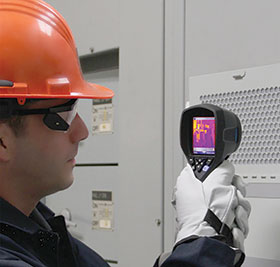

A paper mill in South Carolina had a very successful infrared inspection program that management wanted to expand. However, regulatory requirements were causing them to rethink the strategy since inspection of energised equipment was becoming more restrictive, more time consuming, and more costly. Furthermore, 8% of the mill’s applications had never been surveyed due to switched interlocks that automatically de-energise the equipment upon opening, or, due to incident energy in excess of the personal protective equipment (PPE) ratings that would place personnel in danger.
In search of alternate methods for conducting safer inspections, the reliability engineer investigated how infrared inspection windows (IR windows) might be utilised. It was determined that:
• Use of IR windows for routine inspections of healthy equipment did not require the elevated levels of PPE required by regulation.
• Use of infrared windows would provide an efficient method to perform inspections.
• Use of IR windows would provide non-intrusive access to electrical applications, allowing surveys to be conducted without elevating risk to plant assets and processes, meaning that inspections could be conducted during peak hours for the best diagnostic data.
• Use of IR windows would eliminate high-risk tasks during inspections and thereby increase safety for thermographers.
Installation and cost analysis
Installation of 197 IR windows was conducted over three days of the annual shutdown. Although the plan allowed for 12 hour shifts, installers were able to move at a rate of approximately six window installations per hour, which allowed all window installations to be completed well within the allotted timeline. Total cost for the windows plus installation was approximately $60 000.
Prior to the installation of the IR windows, all infrared inspections were completed on open, energised gear. Therefore, PPE, live works procedures, risk assessments, permits, etc. were required for all inspections, and as noted earlier, several applications had never been surveyed due to safety restrictions. The paper mill had previously invested in its own infrared camera and an on-staff thermographer. The thermographer was trained and ‘qualified’ to assist in opening panels on energised gear. Therefore, some efficiency was already in place when compared to a typical crew of a single thermographer and two electricians. Total cost of traditional inspection using the in-house team came to approximately $41 000 per inspection cycle.
After the IR windows were installed and there was no need to remove panels or wear increased levels of PPE, the task became a one-man job. The increased efficiency significantly decreased the time required to complete a survey to just two, eight-hour days for a total of just 16 man-hours. Total cost of inspection using IR windows came to approximately $2 000 per inspection cycle i.e. a saving of $39 000 per inspection cycle.
Return on investment
ROI for the paper mill – based on the initial investment of the windows plus installation and the costs to perform surveys using the windows, compared with the mill’s traditional costs of using their in-house team while not using windows – began to accrue by third inspection cycle. In just five inspection cycles, the mill showed savings of over $135 000.
Conclusion
This mill realised a return on investment quickly, while also benefitting from the follwing:
• The ability to inspect previously ‘non accessible’ equipment.
• The ability to inspect critical applications more frequently.
• The ability to monitor applications suspected to be running towards failure.
• Increased safety for personnel.
• Decrease in risk to plant assets and operations due to the non-invasive nature of inspections.
• Freeing up personnel to be utilised for other jobs on the plant.
IR windows provided the mill with a cost-effective and safer alternative to traditional equipment inspections.
For more information contact R&C Instrumentation, +27 11 608 1551, [email protected], www.randci.co.za
| Tel: | +27 11 608 1551 |
| Email: | [email protected] |
| www: | www.randci.co.za |
| Articles: | More information and articles about R&C Instrumentation |

© Technews Publishing (Pty) Ltd | All Rights Reserved